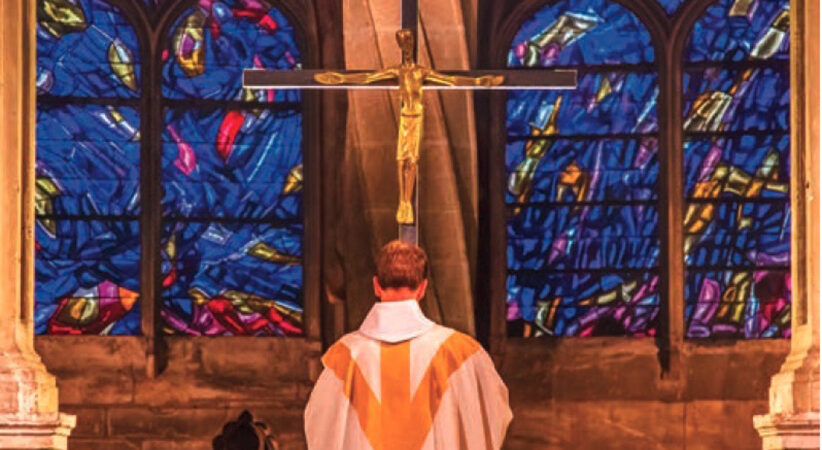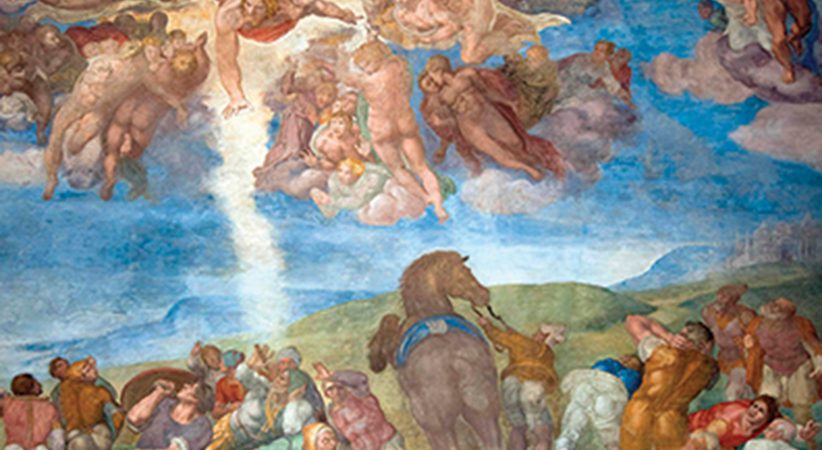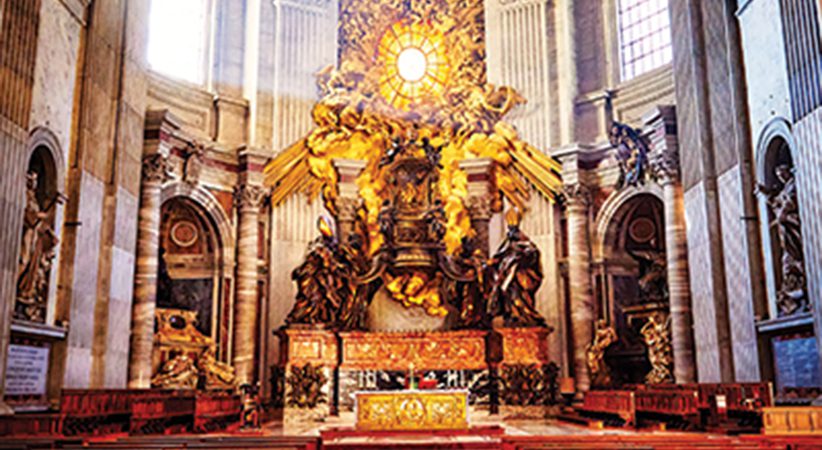Configuration to Christ the Priest
Having our lives shaped by Christ and remaining in his presence
Deacon James Keating Comments Off on Configuration to Christ the Priest
“Come, follow me” (Lk 18:22). Complex responses may be evoked in those who hear this simple invitation. In the context of the Gospel of Luke, the one receiving this invitation refused it and went away “sad” (v. 23). He could not or would not respond.
Most humans, upon hearing this call, immediately count the cost, hence, the emergence of this simple call’s complexity. I may want to follow Christ, but at once all the idols of immediate self-gratification raise their hectoring voices as they did to St. Augustine: “Do you think you can live without us?” (“Confessions,” Book 8). This simple call from Christ, then, sets up the drama of our lives: Can we trust Christ to heal our nostalgia for sin as we commit to a life of contemplating his mysteries? Will we accompany him long enough to find out?
The expression that captures this drama of following Christ, and one which now has come to the fore in priestly formation, is configuration. To be configured to Christ is to live a life shaped by remaining in his presence. In the current Ratio Fundamentalis (“The Gift of the Priestly Vocation”) for priestly formation, promulgated under Pope Francis’ authority, Christic configuration is explored as a profoundly contemplative reality (cf. No. 68).
Proper Spiritual Formation
When embraced fully, being configured to Christ yields the spiritual formation proper to a priest. Pope Emeritus Benedict XVI described it this way, “To follow Christ means learning to keep our gaze fixed on him, growing close to him, listening to his word, and encountering him in the sacraments … learning to conform our will to his” (“Called to Holiness,” The Catholic University of America Press, $24.95).
These remarks explicate the drama of configuration plainly: Am I that interested in Christ to contemplate him? Am I that committed to his mission to fix my gaze upon him, conform my will to his? Do I allow lesser objects of attention to gain entry into my heart?
To attend to these lesser interests is to turn away from the shaping influence of Christ’s presence and remain “sad.” Such sadness is triggered, according to Dietrich von Hildebrand, in our failure to remain in a recollected state. “Recollection is primarily the antithesis to distraction … a state of being dragged along from one object to another, never touching any of them but superficially” (“Transformation in Christ,” Ignatius Press, $24.95).
‘Dragged’
That reads like a perfect description of the popular culture we all presently inhabit: “dragged along from one object to another … superficially.” Whether we call it a distraction or temptation, our failure to fix our gaze upon Christ carries the inevitable consequence of having superficial objects crowd out a life of being configured to Christ.
When our gaze is no longer fixed on Christ, we begin to drift along from one superficial distraction to the next. Waking up, by grace, to such a state of drifting can shock the emotions of a cleric, leaving him to wonder: “How did this happen to me?” Such drifting can even bring one to despair over the state of one’s clerical vocation in its present condition.
But despair is a spiritual dead end. Instead, we are called to fight, push against such despair and remain with Christ. We, as well, are to push against any self-recrimination about choosing to taste the “fast-food” interests of the culture instead of consuming the more substantial “bread of life” (Jn 6:35).
Remaining in interior conversations with the self about these negative judgments do not bring life to our spirit. We have to push against the sadness and self-hate because in failing to do so we mischaracterize evil as something we can “come to terms with” as Conrad W. Bars wrote in “I Will Give Them a New Heart” (Alba House, $21.95).
The Fight
Where necessary, we fight. Evil is rejected, not negotiated with. The primary way to reconfigure the clerical heart to Christ is to resist the drift of the mind toward “low and earthly things” (Rule 4 of St. Ignatius’ Rules for Discernment). Part of this resistance involves a good confession and an appointment with our spiritual director. But most essentially, the configuration begun in seminary can be shaped anew by our intentional presence at Mass … the place where the living God calls out to us from his surrendered body out of love for ours. St. John Vianney said, “If only we could comprehend all the good things contained in the Eucharist, nothing more would be wanting to content the heart of man.”
By daily offering himself into Christ’s own self-offering at the Mass, a priest finds the regenerating cure to any anemic participation in Christ’s own priesthood. The Eucharist stands as its own objective reality; the divine offering of salvation to all humankind. But it also invites the priest to find personal spiritual renewal there.
Individual priestly regeneration can be had at worship since the priesthood was born in the Eucharist (cf. Ratio Fundamentalis, No. 36). The Mass remains the fount of renewal, a participative encounter leaving one’s priesthood created again, revivified, and one’s identity as a man of discernment (cf. No. 43) and pastoral charity restored. Of course, this restoration is a human experience, so such regeneration is progressive and developmental, not instantaneous. Christ is configuring and restoring. He is seeking to gift a man with a life of communion, not one of immediate gratification even in spiritual things.
To see the Eucharist as this event of renewal, to desire to live in its truth, is to be a priest who comes to possess “the mind of Christ” (1 Cor 2:16). To think like Christ is the very essence of being configured to him. From such, a mind flows a burning pastoral charity, one that suits a man who has left all, sacrificed wife and children, sensing the celibate call as life and life to the full (cf. Jn 10:10).
From the beginning of seminary, Christ wants to ultimately live his priestly mystery over again in such a body. All of one’s formation, when done well and at the service of maturing in the Lord, aims at Christological configuration. This is why pastoral charity is held up as one of the hallmarks of a Catholic priest. He is a man who follows Christ to the altar unto sacrifice and within ministry unto forgiveness of sins.
“The sequela of Christ has a much higher goal: to be assimilated into Christ, that is to attain union with God. … The only path is communion with Christ, achieved in the sacramental life.” The following of Christ “is not a question of morality, but a ‘mysteric’ theme — an ensemble of divine action and our response … uniting oneself to his love … which becomes the birth of the new man” (Cardinal Joseph Ratzinger, address to catechists and religion teachers, Dec 12, 2000).
Priestly renewal is always this mystic renewal, regeneration at sacramental sources. In this way, the priest’s reconfiguration to Christ is grounded in the objectivity of Christ’s own actions toward him. Knowing these sacramental sources, as actions where God is personally engaged, a priest commends them to those he serves. Such pastoral charity is born of a personal history of the priest’s own dependency upon the Paschal Mystery. Such an exercise of pastoral charity, his bringing parishioners deep into the sacramental life, expresses Christ’s own spousal identity. As a “husband” (Pastores Dabo Vobis, No. 23) the priest provides and protects; he will not fail to provide for his hungry “spouse,” turning her away from consuming the superficialities of the culture. Nor will he fail to protect the parish as this same culture’s worship of contemporary idols threatens to undermine Christ’s Bride’s identity.
If Pope Francis is right that configuration is a profoundly contemplative reality, then each cleric is invited into a life of interiority, a way of beholding the mysteries of Christ in prayer. In the Ratio Fundamentalis, which covers not only seminary formation but priestly ongoing formation, it states that the laity have a “right” to ministry from a priest who pursues holiness (No. 82). “There is no need for … functionary priests, who while playing a role, seek their consolation far from him. Only one whose gaze is fixed on what is truly essential can renew his ‘yes’ to the gift received” (No. 84).
Satan’s common ruse is to tempt the cleric to remove his gaze from what is truly essential (the life, death and resurrection of Christ), and to have it fall upon the realities of this passing age. Another temptation is to have the priest become ashamed of his cultic priestly duties as if they stemmed from his ego or his need to hold power. When present within a priest of integrity, a love for cult is not an empty show or a wielding of domination; such love is the culmination of an obedience born in the depths of relatedness to the mysteries of Christ himself.
There are current voices wishing to reduce priesthood to an office of service in a way that levels the ministerial playing field. However, priests who love the Eucharist as their vocational center, and surest foundation for Christological configuration, do not threaten the truth that “the unity and dignity of the baptismal vocation precede any differentiation in ministry” (No. 31). In fact, they serve this truth.
Not a Cultic Role
It is not a priest’s cultic role, nor his love for it, that diminishes lay or diaconal ministry, only personal character flaws can do that. Some think that a priest who reflects upon, loves and desires to preside at the Eucharist “isolates” himself, exults himself unto a life of sequestered clericalism. In common parlance, there is fear that priests who love their cultic role belong to a “club,” one wherein power and secrets are kept. But secrets involving any sexual sins of priests, or power used to keep these secrets or to abuse the rightful service of laity and deacons, are areas of needed personal and institutional reform.
The love a priest has to celebrate Mass is not suspect, but praiseworthy. Some religious order priests note a lack in their liturgical formation in schools of theology where the priesthood was reduced to “service” in an attempt to be inclusive of the laity studying alongside them. The Eucharist, and the priest’s vocation within that sacrament, calls for more contemplation about its truth, not less. Priesthood understood as “service” or as “enabler of others’ gifts” is more political than theological.
In its own right, priesthood is Christological and mystical. Being a priest who loves the Mass (cultic priest) and seeks holiness through its Christological configuration is not the problem with contemporary sacerdotal formation. Being a priest who wishes to please the current ideological drift and conflate legitimate vocational distinctions in a politicized way may well be. Being a priest who is doctrinally orthodox and unashamed of his supernatural vocation are not “aged-out” categories in need of “creative” ideological breezes from university professors or members of religious orders.
Diocesan priestly formators already know what is needed to help secure a future of sound parish leadership: men configured to “Christ the Priest … who did not offer the blood of goats … but his own blood” (Ratio Fundamentalis, No. 36). The priesthood and the Eucharist were “born together” (No. 36) and the agent of that birth, Christ, now lives in the bodies of those men he calls to follow him.
Such a simple call to future priests requires bravery and humility since a “yes” culminates in an offering of “blood” (life) in and through Christ’s own. Here is where the ministerial and baptismal priesthood clearly differ “in essence and not only in degree” (No. 31): in a man who leads (cf. No 32) the sacramental sacrifice at the altar, and offers his personal life as a sacrifice in a daily unified act of configuration to the mind of Christ so as to serve needs not his own.
DEACON JAMES KEATING, Ph.D., is a professor of spiritual theology at Kenrick-Glennon Seminary in St. Louis, Missouri.
…………………………………………………………………………………………………………………………………………….
Pope Benedict XVI’s message about vocations

In his message for the 48th World Day of Prayer for Vocations in 2010, Pope Benedict XVI said: “It is a challenging and uplifting invitation that Jesus addresses to those to whom he says: ‘Follow me!’ He invites them to become his friends, to listen attentively to his word and to live with him. He teaches them complete commitment to God and to the extension of his kingdom in accordance with the law of the Gospel: ‘Unless a grain of wheat falls into the earth and dies, it remains alone; but if it dies, it bears much fruit’ (Jn 12:24). He invites them to leave behind their own narrow agenda and their notions of self-fulfillment in order to immerse themselves in another will, the will of God, and to be guided by it. He gives them an experience of fraternity, one born of that total openness to God (cf. Mt 12:49-50) which becomes the hallmark of the community of Jesus: ‘By this everyone will know that you are my disciples, if you have love for one another’ (Jn 13:35).”
……………………………………………………………………………………………………………………………………………….





